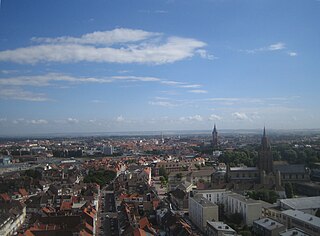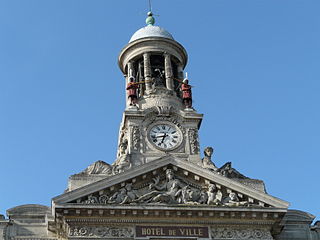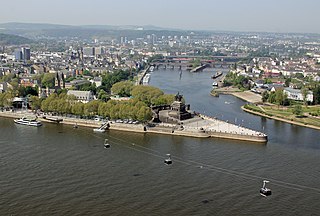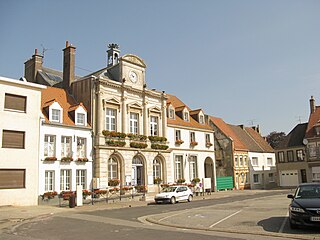
The Panthéon is a monument in the 5th arrondissement of Paris, France. It stands in the Latin Quarter, atop the Montagne Sainte-Geneviève, in the centre of the Place du Panthéon, which was named after it. The edifice was built between 1758 and 1790, from designs by Jacques-Germain Soufflot, at the behest of King Louis XV of France; the king intended it as a church dedicated to Saint Genevieve, Paris's patron saint, whose relics were to be housed in the church. Neither Soufflot nor Louis XV lived to see the church completed.

The Basilica of Saint-Denis is a large former medieval abbey church and present cathedral in the commune of Saint-Denis, a northern suburb of Paris. The building is of singular importance historically and architecturally as its choir, completed in 1144, is widely considered the first structure to employ all of the elements of Gothic architecture.

Calais is a French port city in the Pas-de-Calais department, of which it is a subprefecture. Although Calais is by far the largest city in Pas-de-Calais, the department's prefecture is its third-largest city of Arras. The population of the city proper is 67,544; that of the urban area is 144,625 (2020). Calais overlooks the Strait of Dover, the narrowest point in the English Channel, which is only 34 km (21 mi) wide here, and is the closest French town to England. The White Cliffs of Dover can easily be seen on a clear day from Calais. Calais is a major port for ferries between France and England, and since 1994, the Channel Tunnel has linked nearby Coquelles to Folkestone by rail.

Cambrai, formerly Cambray and historically in English Camerick or Camericke, is a city in the Nord department and in the Hauts-de-France region of France on the Scheldt river, which is known locally as the Escaut river.

Arras is the prefecture of the Pas-de-Calais department, which forms part of the region of Hauts-de-France; before the reorganization of 2014 it was in Nord-Pas-de-Calais. The historic centre of the Artois region, with a Baroque town square, Arras is in northern France at the confluence of the rivers Scarpe and Crinchon.

Boulogne-sur-Mer, often called just Boulogne, is a coastal city in Northern France. It is a sub-prefecture of the department of Pas-de-Calais. Boulogne lies on the Côte d'Opale, a touristic stretch of French coast on the English Channel between Calais and Normandy, and the most visited location in the region after the Lille conurbation. Boulogne is its department's second-largest city after Calais, and the 183rd-largest in France. It is also the country's largest fishing port, specialising in herring.

Koblenz is a German city on the banks of the Rhine and the Moselle, a multinational tributary.

BapaumeFrench pronunciation:[bapom] is a commune in the Pas-de-Calais department in the Hauts-de-France region of northern France.

Guînes is a commune in the northern French department of Pas-de-Calais. Historically, it was spelt Guisnes.

The County of Artois was a historic province of the Kingdom of France, held by the Dukes of Burgundy from 1384 until 1477/82, and a state of the Holy Roman Empire from 1493 until 1659.

The Battle of Gravelines was fought on 13 July 1558 at Gravelines, near Calais, France. It occurred during the twelve-year war between France and Spain (1547–1559).

The July Column is a monumental column in Paris commemorating the Revolution of 1830. It stands in the center of the Place de la Bastille and celebrates the Trois Glorieuses — the 'three glorious' days of 27–29 July 1830 that saw the fall of Charles X, King of France, and the commencement of the July Monarchy of Louis-Philippe, King of the French. It was built between 1835 and 1840.

The European route E15 is part of the United Nations international E-road network. It is a north–south "reference road", running from Inverness, Scotland south through England and France to Algeciras, Spain. Along most of its route between Paris and London, the road parallels the LGV Nord and High Speed 1. Its length is 2,300 miles (3,700 km).

The Château de Boulogne-sur-Mer is a castle in the French seaport of Boulogne-sur-Mer, in the Pas-de-Calais département. It houses the Boulogne museum.

The Pale of Calais was a territory in northern France ruled by the monarchs of England from 1347 to 1558. The area, which centred on Calais, was taken following the Battle of Crécy in 1346 and the subsequent Siege of Calais, and was confirmed at the Treaty of Brétigny in 1360, in the reign of Edward III of England. It became an important economic centre for England in Europe's textile trade centered in Flanders.

The Column of the Grande Armée is a 53 metre high Corinthian order triumphal column on the Rue Napoleon in Wimille, near Boulogne-sur-Mer, France.

Porte d'Aix is a triumphal arch in Marseille, in the south of France, marking the old entry point to the city on the road from Aix-en-Provence. The classical design by Michel-Robert Penchaud was inspired by the triumphal arches of the Roman Empire. The Porte d’Aix was initially conceived in 1784 to honour Louis XVI and to commemorate the Peace of Paris (1783) that ended the American Revolutionary War. Following the restoration of the Bourbon monarchy in 1814–15, the project was resumed in 1823, now to commemorate French victories in the Spanish Expedition, notably at the Battle of Trocadero, August 31, 1823. It was eventually completed in 1839, with a more general theme of victory.

The French siege of Calais in early 1558 was part of the Italian War of 1551–1559 between France and England and their respective allies. It resulted in the seizure of the town and its dependencies by France.

The French Provisional Government of 1814 held office during the transitional period between the defeat of Napoleon followed by the surrender of Paris on 31 March 1814 and the appointment on 13 May 1814 of the Government of the first Bourbon restoration by King Louis XVIII of France.

The Dover Patrol Monuments are a trio of war memorials designed by Sir Aston Webb to commemorate the Royal Navy's Dover Patrol of the First World War. Two identical granite memorial obelisks, 75 feet (23 m) high, were erected near Dover and on the Cap Blanc-Nez near Calais in 1921 and 1922. A third was erected in Brooklyn, New York, in 1931. The UK monument became a Grade II listed building in August 1966, promoted to Grade II* in August 2015.





















